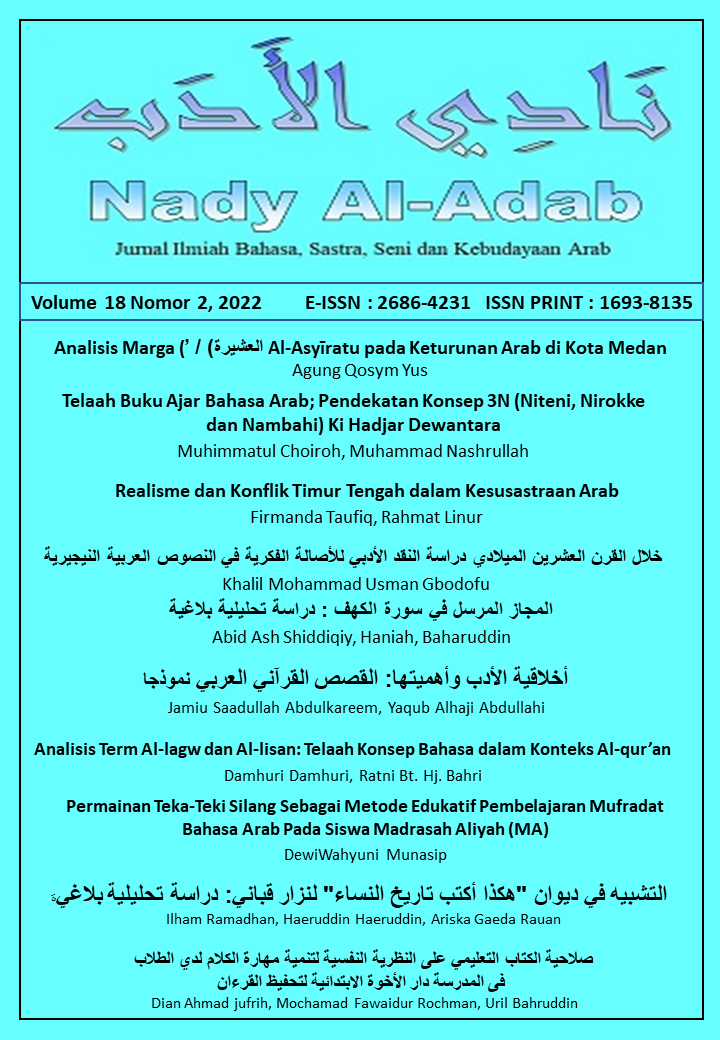Telaah Buku Ajar Bahasa Arab; Pendekatan Konsep 3N (Niteni, Nirokke dan Nambahi) Ki Hadjar Dewantara
DOI:
https://doi.org/10.20956/jna.v18i2.18529Abstract
ABSTRACT One aspect that must follow the development of an age is education, education has an important role in developing student intellectual attitudes. An alternative that can be done to develop the intellectual attitude of students is by examining the concept of the teachings of 3N in student textbooks, in this case the Arabic textbook. 3N is one of the teachings of the Tamansiswa used by Ki Hadjar Dewantara in the learning process. This article aims to examine or analyze the Arabic textbook students use a 3N approach. This research is descriptive qualitative with a type of library research then using content analysis. The results of this study are indicators of the Niteni process, Nirokke, and Nambahi in the Arabic textbook of the Madrasah Tsanawiyah class VIII of the Indonesian Ministry of Religion Mold in 2020, this shows that the Arabic textbook of the Madrasah Tsanawiyah Class VIII of the Ministry of Religion of the Republic of Indonesia in 2020 is decent used as one of the Arabic language teaching materials in school, because it has a 3N element, namely Niteni, Nirokke and Nambahi. Keywords: Niteni, Nirokke, Nambahi, and Arabic textbookDownloads
References
Arikunto, Suharsimi. Prosedur Penelitian Suatu Pendekatan Praktik, Penerbit Rineka Cipta: 2010.
Budiati, N., Istiqomah, Purnami, A. S., & Agustito, D. (2018). Penerapan konsep 3N (niteni, nirokke, nambahi) dalam pembelajaran matematika. Prosiding Seminar Nasional Pendidikan Matematika Etnomatnesia, 486–490.
Choiroh, M., & Taufiq, M. A. (2020). Gender dalam Buku Pendidikan Bahasa Arab Al-`Ashri Kelas X: Studi Analisis Teks Pola Diskriminasi Gender. El Ibtikar, 9(2), 241–256.https://syekhnurjati.ac.id/jurnal/index.php/ibtikar/article/download/6429/pdf_45
Damayanti, S., & Rochmiyati, S. (2019). Telaah Penerapan Tri-N (Niteni, Nirokke, Nambahi) Pada Buku Bahasa Indonesia Kelas Ix Smp. Jurnal Muara Pendidikan, 4(2), 388–397. https://doi.org/10.52060/mp.v4i2.174
Dewantara, K. H. (1977). Karya Ki Hajar Dewantara. Yogyakarta: Majelis Luhur Persatuan Taman Siswa
Faoziyah, L. (2020). Analisis Buku Ajar Bahasa Arab Madrasah Aliyah Berdasarkan Kurikulum 2013. http://repository.iainpurwokerto.ac.id/7635/
Ishak, M. S. (2018). Hubungan Antara Penguasaan Sintaksis Dan Penguasaan Nahwu Pada Mahasiswa Jurusan Pendidikan Bahasa Arab Iain Pontianak Midyan Surya Ishak Hubungan Antara Penguasaan Sintaksis Keterampilan menulis dalam bahasa Arab adalah salah satu kemampuan penting yang. Alfazuna, 3(1).
Masrukhin, Bahasa Arab Madrasah Tsanawiyah Kelas VIII, Direktorat KSKK Madrasah, Cetakan ke-1, Tahun 2020
Nurcahyo, L. (2020). Pendekatan konsep Merdeka Belajar dalam pembelajaran Seni Rupa di era industri 4.0. Seminar Nasional Seni Dan Desain …, 143–150. https://proceedings.sendesunesa.net/publications/333157/pendekatan-konsep-merdeka-belajar-dalam-pembelajaran-seni-rupa-di-era-industri-4
Rahayu, S., & Rochmiyati, S. (2019). Penerapan Tri-N dalam Buku Teks Siswa Bahasa Indonesia untuk Siswa SMP Kelas VIII Kurikulum 2013. Silampari Bisa: Jurnal Penelitian Pendidikan Bahasa Indonesia, Daerah, Dan Asing, 2(2), 173–184. https://doi.org/10.31540/silamparibisa.v2i2.594
Samho, B., & yasunari, O. (2013). Konsep Pendidikan Ki Hadjar Dewantara dan Tantangan-Tantangan Implementasinya Di Indonesia Dewasa ini. Journal of Chemical Information and Modeling, 53(9), 1689–1699.
Taufiq, M. A., & Nashrullah, M. (2021). Analisis Buku Bahasa Arab Pegangan Guru dan Siswa Kelas XI Kurikulum 2013 Cetakan Kementerian Agama. TSAQOFIYA: Jurnal Pendidikan Bahasa Dan Sastra Arab, 3(1), 16–25. https://doi.org/10.21154/tsaqofiya.v3i1.51
Umam, M. K., & Syamsiyah, D. (2020). Konsep Pendidikan Humanistik Ki Hadjar Dewantara dan Relevansinya Terhadap Desain Pembelajaran Bahasa Arab. EDULAB: Majalah Ilmiah Laboratorium Pendidikan, 4(2), 59–82. https://doi.org/10.14421/edulab.2019.42-04
Yuli Prihatni. (2014). Pendekatan Saintifik dalam Ajaran Ki Hadjar Dewantara. Hasil Penelitian LP2M UST.
Downloads
Published
How to Cite
Issue
Section
License

This work is licensed under a Creative Commons Attribution-NonCommercial 4.0 International License.
All right reserved. The articles in this journal are under copyright of journal Nady al-Adab and the author of the article. No part of the articles may be reproduced without permission of the journal management



















